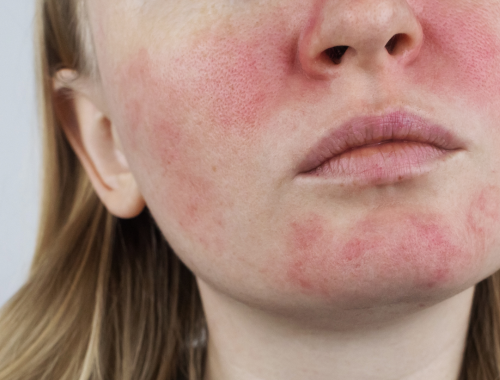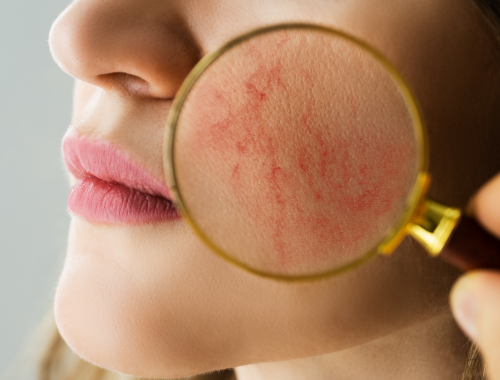Difference Between Couperose and Rosacea
Couperose is a chronic inflammatory skin disorder due to weakened blood vessels in the face, resulting in persistent redness and flushing. Rosacea is an inflammatory skin condition that manifests as a prominent red appearance on the face and eyes.

What is couperose?
Definition:
Couperose is a chronic inflammatory skin disorder due to weakened blood vessels in the face, resulting in persistent redness and flushing.
Causes:
The exact cause of couperose is not known, however, it is linked with genetics and environmental factors. Triggering factors of the condition are hot beverages, spicy food, citrus, chocolate, tomatoes, UV exposure, exercise, and certain vessel-dilating drugs.
Symptoms:
Symptoms of couperose include facial redness and flushing in cheeks, prominent blood vessels, purging of skin, pimple eruption and pustules on the face, thickened skin on the nose, enlarging nose, and dry edematous eyes.
Diagnosis:
Couperose is diagnosed based on medical history and physical examination.
Treatment:
Treatment of couperose involves managing symptoms. Avoidance of triggers, topical sunscreens, creams containing azelaic acid, pulsed light therapy, and acne medications are some options that can prevent the flare-up of the disease.

What is rosacea?
Definition:
Rosacea is an inflammatory skin condition that manifests as a prominent red appearance on the face and eyes.
Symptoms:
Common signs and symptoms of rosacea include frequent flushing which is bouts of facial redness, persistent redness, red bumps and pimples of skin, telangiectasia, irritation in the eyes, a stinging or burning sensation on the face, and facial edema.
Location:
Rosacea affects the nose, chin, cheeks, eyes, forehead, ears, scalp, neck, and chest.
Causes:
The exact cause of rosacea is unknown. However, the disease is considered inflammatory. The abundance of skin mites or the presence of an ongoing infection is known to cause rosacea. Also, the malfunction of protective skin proteins is linked with the disease.
Diagnosis:
Rosacea is diagnosed by a dermatologist through medical history and physical examination.
Treatment:
Oral medications like antibiotics and topical gels like Brimonidine and azelaic acid are used to subside pimples and redness in rosacea. Laser treatment can control telangiectasia and surgery might be needed if nose disfigurement occurs.
Difference between couperose and rosacea
Definition:
Couperose is a chronic inflammatory skin disorder due to weakened blood vessels in the face, resulting in persistent redness and flushing. Rosacea is an inflammatory skin condition that manifests as a prominent red appearance on the face and eyes.
Causes:
The exact cause of couperose is not known, however, it is linked to genetics and environmental factors. Triggering factors of the condition are hot beverages, spicy food, citrus, chocolate, tomatoes, UV exposure, exercise, and certain vessel-dilating drugs. The exact cause of rosacea is unknown. however, the disease is considered inflammatory. The abundance of skin mites or the presence of an ongoing infection is known to cause rosacea. Also, the malfunction of protective skin proteins is linked with the disease.
Symptoms:
Symptoms of couperose include facial redness and flushing in cheeks, prominent blood vessels, purging of skin, pimple eruption and pustules on the face, thickened skin on the nose, enlarging nose, and dry edematous eyes.
Common signs and symptoms of rosacea include frequent flushing which is bouts of facial redness, persistent redness, red bumps and pimples of skin, telangiectasia, irritation in the eyes, a stinging or burning sensation on the face, and facial edema.
Diagnosis:
Couperose is diagnosed based on medical history and physical examination. Rosacea is diagnosed by a dermatologist through medical history and physical examination.
Treatment:
Treatment of couperose involves managing symptoms. Avoidance of triggers, topical sunscreens, creams containing azelaic acid, pulsed light therapy, and acne medications are some options that can prevent the flare-up of the disease. Oral medications like antibiotics and topical gels like Brimonidine and azelaic acid are used to subside pimples and redness in rosacea. Laser treatment can control telangiectasia and surgery might be needed if nose disfigurement occurs.
Table of differences between couperose and rosacea

FAQs
What does couperose skin look like?
Symptoms of couperose include facial redness and flushing in cheeks, prominent blood vessels, purging of skin, pimple eruption and pustules on the face, thickened skin on the nose, enlarging nose, and dry edematous eyes.
What is the description of couperose?
Couperose is a chronic inflammatory skin disorder due to weakened blood vessels in the face, resulting in persistent redness and flushing.
How to tell the difference between rosacea and normal redness?
Normal redness fades away but rosacea is persistent redness.
Is couperose skin sensitive?
Yes.
Is rosacea the same as broken capillaries on the face?
No, these two are different phenomenons that may or may not present together.
Is vitamin C good for couperose?
Yes, it heals the skin barrier.
- Differences Between Reptiles and Amphibians - May 17, 2024
- Difference Between Ophthalmology and Optometry - May 15, 2024
- Difference Between Fear and Anxiety - April 2, 2024
Search DifferenceBetween.net :
Leave a Response
References :
[0]Powell, Frank C. "Rosacea." New England Journal of Medicine 352.8 (2005): 793-803.
[1]Wilkin, Jonathan K. "Rosacea: pathophysiology and treatment." Archives of dermatology 130.3 (1994): 359-362.
[2]Fizor, N., and A. Ivanova. "Sophora Japonica: the perspectives of use in a new medical form for prevention and treatment of couperose." (2021).
